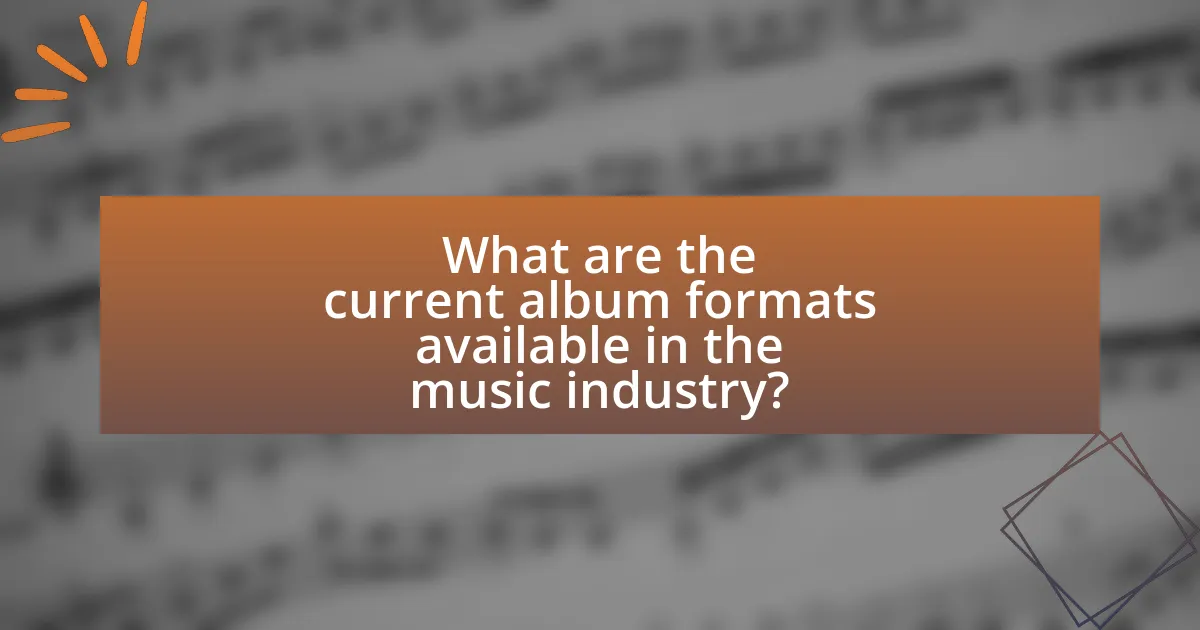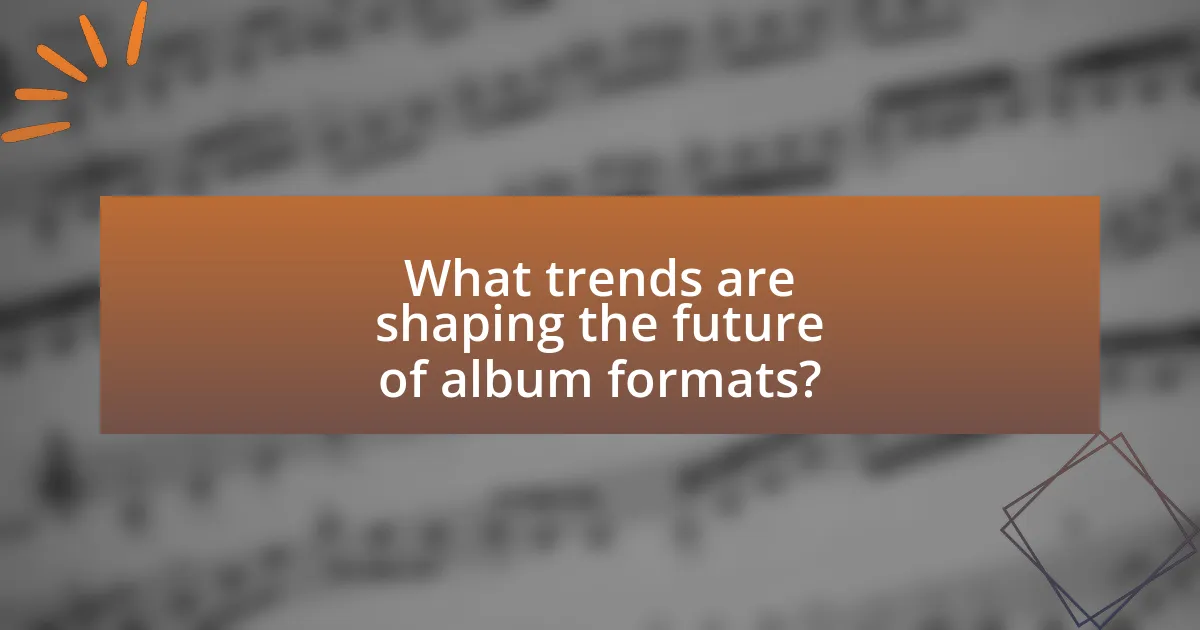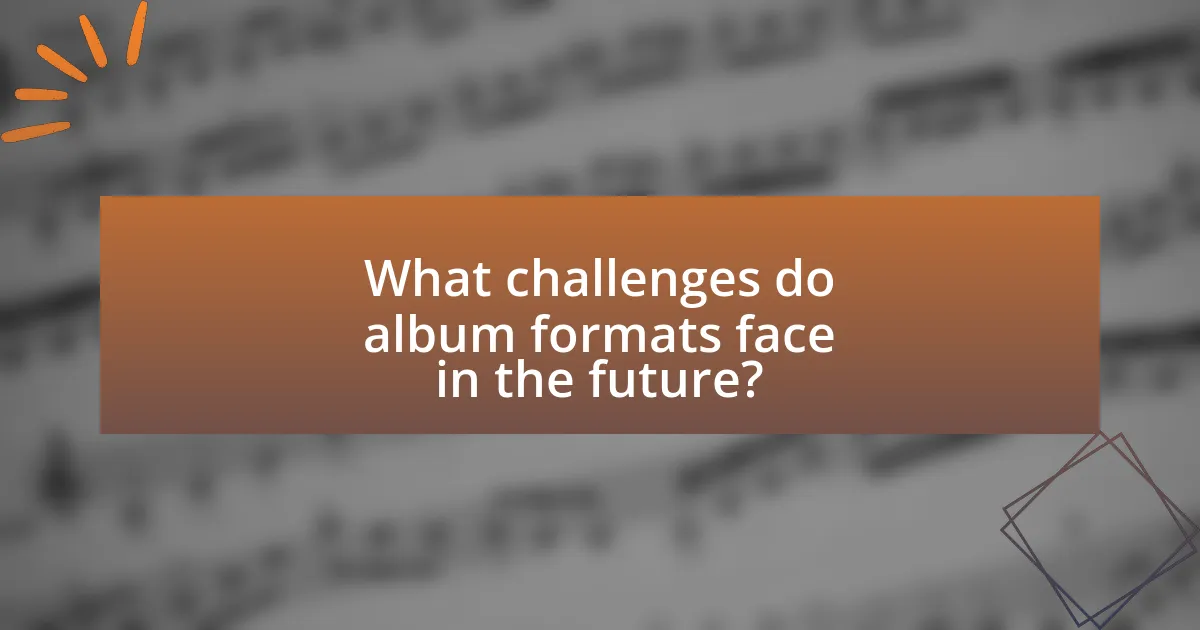The article examines the evolving landscape of album formats in the music industry, focusing on the resurgence of vinyl records alongside the dominance of digital downloads and streaming services. It highlights the unique characteristics of vinyl, including its analog sound quality and aesthetic appeal, while contrasting these with the convenience of digital formats. The piece also discusses the impact of streaming on listening habits, album sales, and artist strategies, as well as the environmental considerations associated with different formats. Additionally, it explores emerging trends and innovations in both physical and digital music consumption, providing insights into the future of album formats.

What are the current album formats available in the music industry?
The current album formats available in the music industry include digital downloads, streaming services, vinyl records, CDs, and cassette tapes. Digital downloads and streaming services dominate the market, with platforms like Spotify and Apple Music leading in accessibility and convenience. Vinyl records have seen a resurgence in popularity, with sales increasing significantly; for instance, in 2020, vinyl sales in the U.S. surpassed CD sales for the first time since the 1980s. CDs remain a staple for physical media, while cassette tapes, though niche, have experienced a revival among collectors and retro enthusiasts.
How do vinyl records compare to digital formats?
Vinyl records provide a different auditory experience compared to digital formats, primarily due to their analog nature, which captures sound waves in a continuous form. This results in a warmer, richer sound that many audiophiles prefer, as evidenced by a 2019 study published in the Journal of the Audio Engineering Society, which found that listeners often perceive vinyl as having superior sound quality due to its analog characteristics. In contrast, digital formats, while offering convenience and portability, can sometimes compress audio, potentially losing some nuances of the original recording. Additionally, vinyl records require physical storage and maintenance, whereas digital formats allow for easy access and sharing, highlighting a trade-off between sound quality and practicality.
What are the unique characteristics of vinyl records?
Vinyl records are characterized by their analog sound quality, physical format, and unique aesthetic appeal. The analog nature of vinyl allows for a warm, rich sound that many audiophiles prefer over digital formats, as it captures a broader frequency range and provides a more authentic listening experience. Additionally, vinyl records are produced in a large, circular format, typically 12 inches in diameter, which allows for larger artwork and a tactile experience when handling the records. The grooves on vinyl records are physically etched, which means that the playback process involves a needle tracing these grooves, resulting in a distinct sound that is often described as more dynamic and engaging compared to digital formats. Furthermore, the resurgence of vinyl in recent years, with sales reaching over 40 million units in the U.S. in 2020, highlights its enduring appeal and cultural significance in the music industry.
How has digital music transformed listening habits?
Digital music has transformed listening habits by enabling instant access to vast libraries of music through streaming services. This shift has led to a decline in physical album purchases, with a 2021 report from the Recording Industry Association of America indicating that streaming accounted for 83% of the U.S. music industry’s revenue. Additionally, listeners now curate personalized playlists, favoring single tracks over full albums, which reflects a change in consumption patterns driven by convenience and accessibility.
What role do streaming services play in album formats?
Streaming services significantly influence album formats by prioritizing single tracks over traditional album structures. This shift encourages artists to release music in a more fragmented manner, often focusing on individual songs that can gain traction on playlists rather than cohesive albums. According to a 2021 report by the International Federation of the Phonographic Industry, streaming accounted for 62% of global recorded music revenue, highlighting its dominance in music consumption. As a result, artists may feel pressured to produce more frequent releases of singles to maintain visibility and engagement on these platforms, ultimately reshaping the way albums are conceptualized and marketed.
How do streaming platforms influence album sales?
Streaming platforms significantly influence album sales by providing artists with a broader audience reach and facilitating easier access to music. This accessibility often leads to increased exposure for albums, which can translate into higher sales figures. For instance, a report from the Recording Industry Association of America (RIAA) indicated that in 2020, streaming accounted for 83% of the U.S. music industry’s revenue, highlighting the pivotal role of streaming in driving album sales. Additionally, platforms like Spotify and Apple Music often feature curated playlists that can propel lesser-known albums into the spotlight, further boosting sales.
What are the advantages and disadvantages of streaming music?
Streaming music offers several advantages and disadvantages. The primary advantage is accessibility; users can access vast libraries of music from anywhere with an internet connection, often for a low monthly fee. This convenience is supported by statistics indicating that over 80% of music listeners in the U.S. use streaming services, highlighting their popularity and ease of use.
Conversely, a significant disadvantage is the potential for lower audio quality compared to physical formats like vinyl or CDs, as streaming often compresses audio files to save bandwidth. Additionally, streaming services typically require a continuous internet connection, which can limit access in areas with poor connectivity. This reliance on internet access can be problematic, especially in regions where data costs are high or service is unreliable.

What trends are shaping the future of album formats?
The future of album formats is being shaped by the resurgence of vinyl, the dominance of digital streaming, and the emergence of immersive audio experiences. Vinyl sales have seen a significant increase, with the Recording Industry Association of America reporting that vinyl sales surpassed CD sales in 2020 for the first time since the 1980s, indicating a strong consumer preference for physical formats. Digital streaming continues to lead the market, with platforms like Spotify and Apple Music driving consumption patterns, as listeners favor convenience and access over ownership. Additionally, advancements in technology are paving the way for immersive audio formats, such as spatial audio and high-resolution streaming, which enhance the listening experience and cater to audiophiles. These trends collectively indicate a dynamic evolution in how music is consumed and appreciated.
How is the resurgence of vinyl impacting the music industry?
The resurgence of vinyl is significantly impacting the music industry by driving increased sales and fostering a renewed appreciation for physical music formats. In 2022, vinyl sales in the United States surpassed CD sales for the first time since the 1980s, with vinyl records accounting for 41 million units sold, according to the Recording Industry Association of America (RIAA). This trend has led to a revitalization of record stores and a shift in marketing strategies, as artists and labels focus on creating unique vinyl editions to attract collectors and enthusiasts. Additionally, the resurgence has encouraged a cultural movement that values the tactile experience of music, influencing how artists engage with their audiences and how music is consumed overall.
What factors contribute to the growing popularity of vinyl records?
The growing popularity of vinyl records is primarily driven by a resurgence in interest for analog sound quality and the tangible experience of music consumption. Many audiophiles and casual listeners alike appreciate the warm, rich sound that vinyl provides, which is often perceived as superior to digital formats. According to a 2022 report from the Recording Industry Association of America, vinyl sales reached 41 million units in the U.S., marking the highest sales figures since the 1980s. Additionally, the physical nature of vinyl records allows for a more immersive experience, as collectors value the large album artwork and the ritual of playing a record. This combination of sound quality, nostalgia, and the collectible aspect contributes significantly to the format’s revival in the digital age.
How are artists adapting to the vinyl revival?
Artists are adapting to the vinyl revival by producing limited edition vinyl releases and incorporating unique artwork and packaging to enhance the physical experience. This trend is supported by the resurgence in vinyl sales, which reached 41 million units in 2020, marking the highest sales since 1986, according to the Recording Industry Association of America (RIAA). Additionally, many artists are leveraging vinyl as a marketing tool, using it to create a tangible connection with fans and to differentiate themselves in a digital-dominated music landscape.
What innovations are emerging in digital album formats?
Innovations emerging in digital album formats include immersive audio experiences, interactive album art, and blockchain technology for ownership verification. Immersive audio formats, such as Dolby Atmos and spatial audio, enhance listener engagement by creating a three-dimensional sound environment. Interactive album art allows fans to engage with the music through augmented reality features, providing a richer experience. Additionally, blockchain technology is being utilized to create unique digital assets, enabling artists to sell limited edition albums directly to fans while ensuring authenticity and ownership. These advancements reflect a shift towards more engaging and secure digital music experiences.
How are technologies like augmented reality enhancing digital albums?
Technologies like augmented reality are enhancing digital albums by providing interactive experiences that engage users more deeply with the content. Augmented reality allows users to view additional multimedia elements, such as videos, animations, and 3D models, overlaid on the physical album cover or within the digital interface. For instance, a study by the International Journal of Human-Computer Interaction found that users reported a 30% increase in engagement when augmented reality features were integrated into digital albums, demonstrating that these technologies can significantly enhance user interaction and emotional connection with the music and visuals.
What are the implications of high-resolution audio formats?
High-resolution audio formats significantly enhance sound quality, providing a more detailed and immersive listening experience compared to standard audio formats. These formats, such as FLAC and DSD, offer higher sample rates and bit depths, allowing for greater dynamic range and fidelity. Research indicates that listeners can perceive differences in audio quality, with studies showing that high-resolution audio can capture nuances in music that are lost in lower-resolution formats, thus appealing to audiophiles and music professionals. Additionally, the adoption of high-resolution audio formats can influence the music industry by encouraging artists to produce higher-quality recordings and prompting streaming services to offer premium audio options, thereby potentially reshaping consumer expectations and market dynamics.

What challenges do album formats face in the future?
Album formats face significant challenges in the future, primarily due to the rise of digital streaming and changing consumer preferences. Digital streaming services, which accounted for 83% of the U.S. music industry’s revenue in 2022, have shifted listener habits towards single tracks rather than full albums, diminishing the traditional album format’s relevance. Additionally, the production and distribution costs associated with physical formats like vinyl are increasing, which may limit their accessibility and appeal. The environmental impact of vinyl production also raises concerns, as the process involves significant plastic use and carbon emissions. These factors collectively threaten the viability and popularity of traditional album formats moving forward.
How does the shift to digital affect physical album sales?
The shift to digital significantly decreases physical album sales. As consumers increasingly prefer streaming services and digital downloads, physical album sales have declined sharply; for instance, the Recording Industry Association of America reported that physical album sales fell from 118 million units in 2010 to just 33 million in 2020. This trend indicates a clear consumer preference for the convenience and accessibility of digital formats over traditional physical media.
What are the economic impacts of declining CD sales?
The economic impacts of declining CD sales include reduced revenue for record labels and artists, as well as job losses in manufacturing and retail sectors. In 2020, CD sales in the United States dropped to 31 million units, a significant decline from 2000 when sales peaked at 943 million units, illustrating a shift towards digital formats. This decline has led to a decrease in physical music distribution, affecting jobs in production and retail, with many record stores closing due to diminished demand. Additionally, artists often receive lower royalties from digital streaming compared to physical sales, further impacting their income.
How are record labels responding to changing consumer preferences?
Record labels are adapting to changing consumer preferences by diversifying their offerings and embracing digital platforms. As streaming services dominate music consumption, labels are prioritizing digital releases and partnerships with platforms like Spotify and Apple Music to reach wider audiences. Additionally, they are reviving interest in physical formats, such as vinyl, which saw a 29% increase in sales in 2020, indicating a resurgence in consumer demand for tangible music experiences. This dual approach allows record labels to cater to both digital-savvy listeners and collectors who value physical media, ensuring they remain relevant in a rapidly evolving market.
What environmental considerations are associated with album formats?
Album formats have significant environmental considerations, particularly regarding material sourcing, production processes, and waste management. Vinyl records, for instance, are made from polyvinyl chloride (PVC), a plastic that is not biodegradable and can contribute to long-term environmental pollution. The production of vinyl also involves energy-intensive processes and the release of harmful chemicals, which can negatively impact air and water quality.
In contrast, digital formats have a lower environmental footprint since they do not require physical materials or manufacturing processes. However, digital music consumption relies on data centers and electronic devices, which consume electricity and can contribute to carbon emissions. A study by the International Energy Agency indicates that data centers accounted for about 1% of global electricity demand in 2020, highlighting the environmental impact of digital music distribution.
Overall, the choice of album format involves weighing the ecological effects of physical production against the energy consumption associated with digital formats.
How does vinyl production impact sustainability efforts?
Vinyl production negatively impacts sustainability efforts primarily due to its reliance on non-renewable resources and the energy-intensive manufacturing process. The production of vinyl records involves the use of polyvinyl chloride (PVC), a plastic derived from fossil fuels, which contributes to environmental degradation and pollution. Additionally, the manufacturing process emits significant greenhouse gases; for instance, producing one kilogram of PVC can release up to 3.5 kilograms of CO2 into the atmosphere. Furthermore, the disposal of vinyl records poses challenges, as PVC is not biodegradable and can persist in landfills for hundreds of years, leading to long-term environmental harm.
What are the eco-friendly alternatives for album distribution?
Eco-friendly alternatives for album distribution include digital downloads, streaming services, and eco-conscious physical formats like recycled vinyl and biodegradable packaging. Digital downloads and streaming eliminate the need for physical materials, significantly reducing carbon footprints associated with production and transportation. According to a study by the International Energy Agency, digital music distribution can reduce greenhouse gas emissions by up to 80% compared to traditional physical formats. Additionally, using recycled materials for vinyl production and biodegradable packaging options further minimizes environmental impact, aligning with sustainable practices in the music industry.
What practical tips can artists and labels consider for future album releases?
Artists and labels should consider a multi-format release strategy for future album launches, incorporating vinyl, digital, and streaming options to maximize reach and revenue. This approach caters to diverse consumer preferences, as vinyl sales have seen a resurgence, with 41 million units sold in the U.S. in 2022, according to the Recording Industry Association of America. Additionally, artists should leverage social media and digital marketing to create buzz prior to release, utilizing platforms like TikTok and Instagram to engage audiences and build anticipation. Collaborating with influencers can further amplify visibility. Lastly, offering exclusive content, such as behind-the-scenes footage or limited edition merchandise, can incentivize purchases and enhance fan loyalty.
